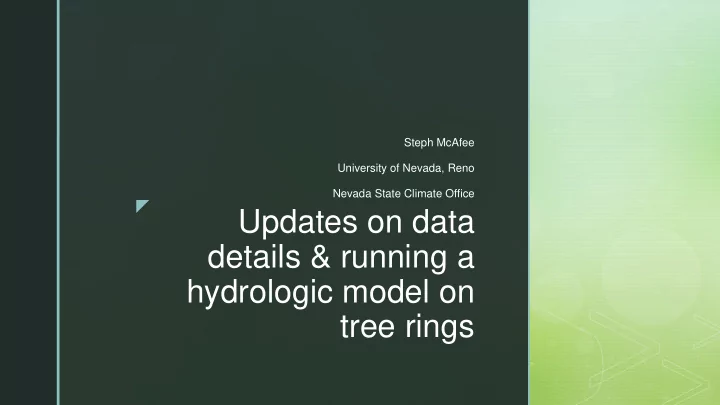

Steph McAfee University of Nevada, Reno Nevada State Climate Office Updates on data details & running a hydrologic model on tree rings
Data details
The number and location of stations changed over time. 1900 1920 1940
Especially since the late 1970s 1960 1970 1980
Average station elevation* has increased. * And a host of other things.
Lapse rates decrease over time.
Minimum temperatures cool as station elevation increases.
So what does this mean? We might be underestimating high-elevation warming. This might mean we’re overestimating the influence of temperature on flow.
Running a hydrological model on tree rings
Theory: plug reconstructions into model
Reality: resolution mismatch Seasonal basin-wide data Monthly grids of data
Resolution: K- nearest neighbor resampling 350 October - April UCRB 300 precipitation (mm) 250 200 150 100 50 1560 1660 1760 1860 1960
K- nearest neighbor resampling Reconstructed October – April precipitation PRISM October : September precipitation Reconstructed May – July temperature PRISM October : September temperature
Theory: one-to-one relationship 350 300 Reconstructed 250 200 150 100 50 50 100 150 200 250 300 350 Observed
Reality: reconstructions miss extremes 350 October - April UCRB 300 precipitation (mm) 250 200 150 Observed 100 Reconstructed 50 1950 1960 1970 1980 1990 2000
Resolution: KNN on percentiles Translate reconstructed 1. amount to percentile. Weighted KNN to select a 2. close percentile. Calculate an adjustment 3. factor. Find the precipitation amount 4. closes to that percentile. Pull all months from that 5. water year. Apply the adjustment to all of 6. them
How’s it look? Precipitation
How’s it look? Temperature
How’s it look? Temperature
In summary Translating the reconstructed temperature and precipitation into data that the Water Balance Model could use required a number of steps, but the process seems to be working!
Recommend
More recommend